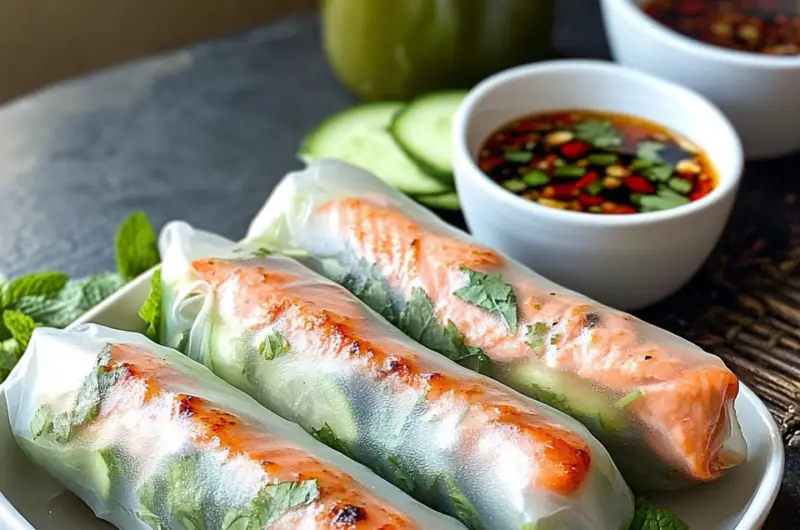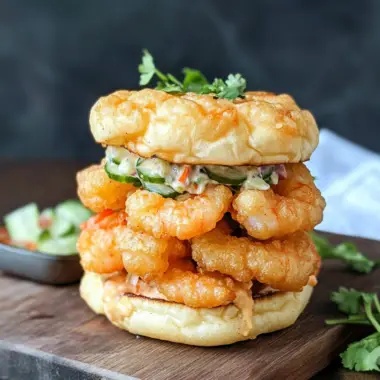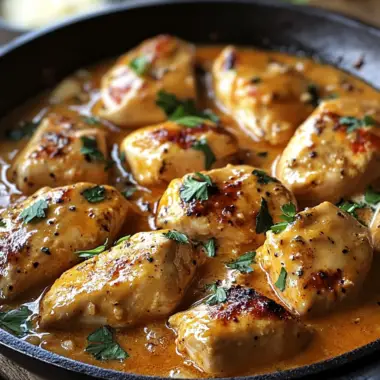The Vietnamese Baked Salmon Spring Rolls are a vibrant twist on the traditional fresh rolls known in Vietnamese cuisine. They combine the richness of oven-baked salmon with crisp vegetables, vermicelli noodles, and aromatic herbs wrapped delicately in rice paper. Unlike fried alternatives, these spring rolls retain the refreshing essence of the original while incorporating the umami depth of gently roasted salmon. Perfect for warm-weather meals, light dinners, or impressive appetizers, this dish offers a balanced mix of protein, fiber, and bold Southeast Asian flavors. It’s also a great way to make use of leftover salmon in a creative, healthy way. Pair it with a tangy dipping sauce like CHAM’s Vietnamese-style nước chấm, and you’ve got a dish that sings with authenticity and freshness.
Full Recipe:
Ingredients:
-
1 lb baked salmon, flaked
-
10 rice paper sheets
-
1 cup vermicelli noodles, cooked
-
1 cup lettuce, shredded
-
1/2 cup cucumber, julienned
-
1/2 cup carrot, julienned
-
1/4 cup fresh mint leaves
-
1/4 cup cilantro leaves
-
1/4 cup Thai basil (optional)
-
1/2 tsp salt
-
1/2 tsp black pepper
-
Dipping sauce (e.g., CHAM sauce or homemade nước chấm)
Directions:
-
Bake salmon at 375°F (190°C) for 12–15 minutes, season with salt and pepper. Let cool, then flake into bite-sized chunks.
-
Dip rice paper into warm water for 5 seconds until pliable.
-
Lay rice paper on a clean surface. Add lettuce, noodles, salmon, herbs, cucumber, and carrot in the lower third.
-
Fold the sides in and roll tightly from the bottom up. Repeat with remaining sheets.
-
Serve with dipping sauce on the side.
Prep Time: 25 minutes | Cooking Time: 15 minutes | Total Time: 40 minutes
Kcal: 240 kcal per roll | Servings: 10 spring rolls
Vietnamese Baked Salmon Spring Rolls: A Modern Twist on a Traditional Favorite
Vietnamese cuisine is globally celebrated for its vibrant flavors, fresh ingredients, and emphasis on balance between taste, texture, and health. Among its most iconic dishes are spring rolls, traditionally known as gỏi cuốn, which are often filled with shrimp, pork, vermicelli noodles, fresh herbs, and wrapped in delicate rice paper. These rolls are typically served with a savory dipping sauce that enhances their complexity. While the classic version holds strong in Vietnamese culinary tradition, modern variations like Vietnamese Baked Salmon Spring Rolls offer a fresh, nutritious, and delightful twist that’s perfect for contemporary palates.
This fusion-style dish maintains the cultural essence of Vietnamese spring rolls while introducing the rich, flaky texture of baked salmon. It’s a brilliant blend of East meets West where heart-healthy protein meets Vietnamese herbs and rice paper, creating a dish that is not only beautiful and vibrant but also satisfying and nourishing. The baked salmon version appeals to those looking for a lighter, protein-rich alternative without sacrificing flavor or authenticity.
The Evolution of Vietnamese Spring Rolls
To understand the beauty of the Vietnamese Baked Salmon Spring Roll, it’s important to appreciate the origin of the traditional fresh spring roll. The original gỏi cuốn is a popular street food and household staple in Vietnam, known for its versatility and adaptability. Typically eaten at room temperature, they are neither fried nor overly seasoned, relying instead on the inherent freshness of their ingredients.
Over time, these rolls have become a canvas for culinary innovation. As more people around the world embraced Vietnamese cooking, chefs and home cooks began exploring new ingredients while maintaining the traditional format. The incorporation of baked salmon represents one such innovation—a natural progression that caters to both taste and nutrition.
Why Baked Salmon Works Perfectly in Spring Rolls
Salmon is a flavorful, fatty fish known for its rich taste and numerous health benefits. High in omega-3 fatty acids, lean protein, and essential vitamins, it makes an excellent choice for health-conscious eaters. When baked, salmon develops a tender texture and intensified flavor profile that complements the delicate nature of fresh vegetables and rice paper.
Compared to shrimp or pork, salmon offers a bolder, more buttery taste that balances exceptionally well with the cooling, herbal qualities of mint, cilantro, Thai basil, and crisp lettuce. Additionally, baking the salmon instead of pan-frying or grilling allows for minimal oil usage, preserving its moisture while keeping the overall dish light.
The inclusion of baked salmon in spring rolls adds a luxurious touch, making the dish suitable not only for casual family meals but also for elegant gatherings, potlucks, and party platters.
Texture, Flavor, and Balance
One of the defining qualities of Vietnamese cuisine is its emphasis on harmony and this dish is a prime example. The soft, flaky salmon contrasts beautifully with the crisp crunch of julienned carrots and cucumbers. Meanwhile, vermicelli noodles add a gentle chewiness that rounds out the mouthfeel.
Fresh herbs like mint, cilantro, and Thai basil deliver aromatic highs that brighten the rich salmon. The rice paper wrapper, delicate and almost translucent, offers a neutral canvas that allows each component to shine.
When dipped into a bold Vietnamese-style sauce whether it be the sweet-savory tang of nước chấm or a creamy hoisin-peanut blend the flavor profile of the spring roll becomes even more vibrant. The sauce acts as a bridge between the ingredients, bringing unity to the dish.
Health Benefits and Dietary Considerations
Vietnamese Baked Salmon Spring Rolls are more than just a tasty treat; they also offer several health benefits:
High Protein, Low Fat
Baked salmon is an excellent source of lean protein and healthy fats, particularly omega-3s, which are known for their anti-inflammatory and heart-protective properties.
Rich in Fiber and Vitamins
The vegetables and herbs packed into these rolls provide ample fiber, antioxidants, and a variety of vitamins such as A, C, and K, which support immune health and skin vitality.
Gluten-Free and Dairy-Free
Made with naturally gluten-free rice paper and free from dairy, these rolls are suitable for those with common food sensitivities or dietary restrictions. For those following a low-carb or keto lifestyle, rice paper can even be substituted with thinly sliced vegetables or collard greens.
Versatile and Customizable
These spring rolls are endlessly customizable. You can add avocado for creaminess, pickled daikon for a tangy crunch, or chili for a touch of heat. The adaptability makes them ideal for meal prepping and accommodating different dietary needs.
Ideal Occasions to Serve Vietnamese Baked Salmon Spring Rolls
These spring rolls are a crowd-pleaser for all kinds of occasions:
-
Healthy Lunch or Dinner: They’re light yet satisfying, perfect for solo meals or family dinners.
-
Picnics and Lunchboxes: Because they can be eaten cold and transport well, they’re great for packed lunches.
-
Appetizers and Potlucks: Visually appealing and easy to eat with your hands, they make excellent starters for any party or social gathering.
-
Post-Workout Meal: The balanced macronutrients (protein, carbs, healthy fats) make it an excellent choice after a workout.
Tips for Perfecting the Spring Roll Technique
Making spring rolls may seem intimidating at first, but with a few simple tips, you’ll be rolling like a pro in no time:
-
Hydration is Key: Don’t soak the rice paper too long; 3–5 seconds in warm water is usually enough. Over-soaking will make them too soft and hard to handle.
-
Dry Your Ingredients: Excess moisture can cause the rice paper to tear or become soggy. Pat vegetables and herbs dry before assembling.
-
Layer Thoughtfully: Place the herbs first, followed by noodles, salmon, and crunchy vegetables. This order makes the rolls more stable and aesthetically pleasing when sliced.
-
Roll Tightly, But Gently: Like wrapping a burrito, tuck in the sides first, then roll from the bottom. Apply light pressure without squeezing too hard.
Sustainability and Ingredient Sourcing
Using baked salmon in spring rolls also provides an opportunity to support sustainable seafood practices. Opt for wild-caught salmon from reputable fisheries when possible, or choose certified sustainably farmed salmon.
In terms of vegetables and herbs, sourcing locally not only enhances freshness but also supports your local economy. Farmers’ markets or homegrown herbs can elevate the flavor of this already delightful dish.
Conclusion:
Vietnamese Baked Salmon Spring Rolls represent the evolution of a classic dish without compromising its roots. They’re flavorful, healthy, and beautifully presentable, offering both comfort and elegance in one neat package. Whether you’re an experienced home cook or a curious beginner, this dish is approachable and endlessly rewarding to make.
Incorporating the rich, tender qualities of baked salmon into the light, fresh structure of a Vietnamese spring roll demonstrates how traditional cuisines can adapt creatively to modern tastes. When paired with a bold dipping sauce and served alongside other Vietnamese favorites, these spring rolls have the potential to become a new staple in your kitchen repertoire.
These rolls invite creativity and personalization, while still staying true to the foundational elements of Vietnamese cooking freshness, balance, and simplicity. From weeknight dinners to special occasions, Vietnamese Baked Salmon Spring Rolls deliver on every level.








